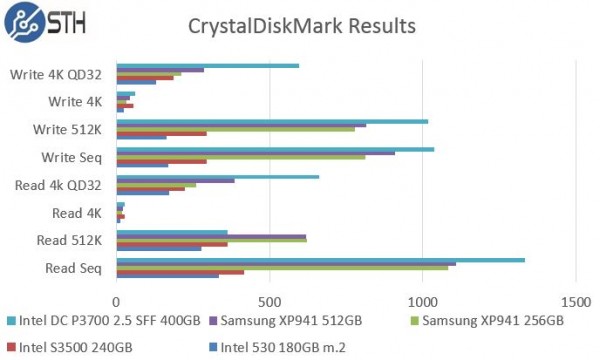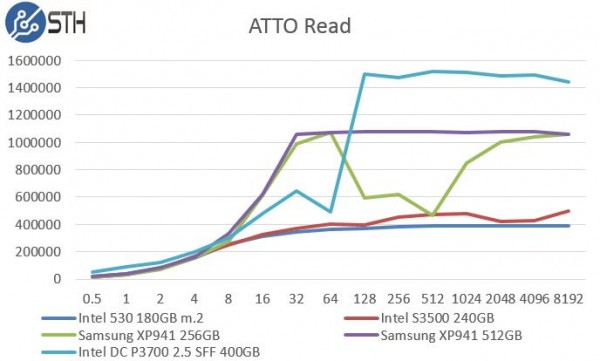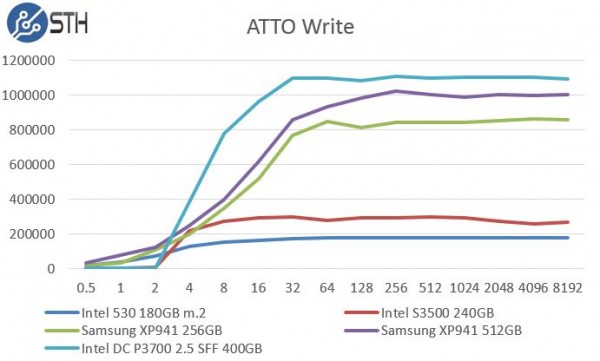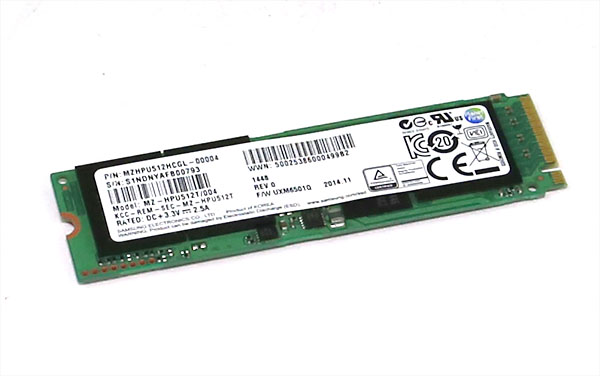The Samsung XP941 has been a mainstay m.2 NGFF PCIe SSD for some time now. It has been used in everything from mobile devices to HP PCIe accelerator cards. While the Samsung XP941 does not boast high write endurance given its target market, it does provide solid PCIe 2.0 generation performance. We recently had the opportunity to test one both in our main SSD testing rig but also in the Supermicro X10SDV-F platform. For those interested in a moderately priced, read focused SSD, the XP941 is a solid option that has been dropping in price as newer generation devices such as the SM951 and Intel 750 become available.
Test Configuration
Since we are going to assume the use of already released hardware, we are using a legacy system for testing across the test suite:
- Motherboard: Gigabyte GA-7PESH3
- Processors: Dual Intel Xeon E5-2690 (V2)
- SAS Controller: LSI SAS 3008
- RAM: 64GB DDR3L-1600MHz ECC RDIMMs
- OS SSD: Kingston V300 240GB
We did utilize our m.2 NGFF to PCIe converter in a PCIe 3.0 x8 slot in order to test these drives.
Samsung XP941 256GB SSD Quick Benchmarks
For our quick tests during this part of the series we will just provide the quick benchmarks with only a bit of commentary. The results should be fairly straightforward and we have added a few results for comparison purposes.
AS SSD Benchmark
AS SSD is a solid benchmark that does not write compressible data to drives. The result is perhaps one of the best workstation SSD benchmarks available today.

We added in the Intel DC P3700 400GB 2.5″ SSD. It draws more power (up to 25w), costs significantly more, but it also shows solid performance in terms of a NVMe SSD. One can see that compared to the Intel 530 180GB m.2 SSD and the Intel DC S3500, the XP941 256GB drive performs extremely well. The larger 512GB XP941 does show some significant performance benefits too.
CrystalDiskMark
CrystalDiskMark is another benchmark which gives non-compressible read/write numbers. This is in contrast to the ATTO Benchmark used by LSI/ Sandforce and its partners when they market a given solid state drive.

In the CrystalDiskMark results we do see an aberration where the Intel DC P3700 falls behind the Samsung XP941’s on the 512K read test. On the other hand, we do see performance generally in-line with what we would expect. One major note here is that if one has the opportunity to purchase the 512GB model, performance is significantly better.
ATTO Benchmark
The value of the ATTO benchmark is really to show the best-case scenario. ATTO is known to write highly compressible data to drives, which inflates speeds of controllers that compress data like LSI/ SandForce does prior to writing on a given solid state drive.

The Samsung XP941 256GB drive did see a strange performance pattern in both our standard test bed as well as the new Intel Xeon D platform we were testing. The 512GB model did not produce similar figures.

On the write side, the XP941 256GB was more consistent. This graph should clearly show why the PCIe based solutions are going to be more prominent for performance storage in the future.
Closing Thoughts
We are just on the verge of the PCIe / NVMe revolution in SSDs. This week’s launch of the Intel 750 SSD will bring a new level of performance to client computing. Samsung made many XP941 drives so they are starting to show up on the secondary market at extremely attractive pricing. The XP941 drive is a great option for a read-intensive server workload, of which there are many. We would likely opt for the Samsung XP941 512GB as it performs slightly better, has more room for over provisioning, and capacity is always good to have.




